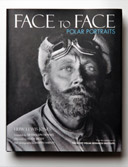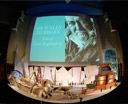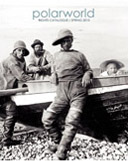 Our ProductsOur Resources |
This website requires the free Flash plugin to be installed.
Polarworld - discover more polar booksThe Arctic Book Review The Last Imaginary Place: A Human History of the Arctic World The Last Imaginary Place: A Human History of the Arctic WorldRobert McGhee Reviewed by Jonathan Dore Like almost any other part of the globe, Robert McGhee argues, the Arctic cannot be imagined from scratch. For those of us who live in temperate latitudes, our ideas of it, as of our own homelands, inescapably comprise a melange of "mythology, history, artistic conventions and all the other cultural factors and associations" that have accumulated over the centuries, like sedimentary layers of immemorial thought. If this were only to say that every person's image of an unknown region is at least partially stereotyped, it would be a commonplace. But McGhee's point is that the Arctic's seemingly radical otherness — its complete lack of agricultural potential, compared to which a tropical rainforest and a temperate river valley seem almost indistinguishable from each other — forces us to make a correspondingly greater effort if we are to overcome our stereotypes and see it not as a world apart, but as part of our own world, and its inhabitants not as people living outside time and divorced from developments elsewhere, but as fully interacting components in the same grand sweep of which everyone else is also a part. It is Robert McGhee's background — as an archaeologist who also has a deep interest in history and geography alike — that makes him so well suited to the task of making this imaginative leap, and helping us to make it with him. McGhee's aim, then, is to tell this "human history of the Arctic world" in a way that places indigenous peoples and southern visitors on the same plane, views them as motivated by the same kinds of impulses, and constricted by the same kinds of economic, climatic and social factors. The reason this requires the skills of an archaeologist as well as a historian is, of course, that no indigenous people of the Arctic has developed its own writing system (apart from the Icelanders, descendents of temperate-latitude Scandinavians and Irish who brought their writing with them). Apart from oral tradition, therefore — whose reliability as a carrier of information about long–past events decays with each intervening generation — the only access we have to knowledge of the Arctic's distant human past is, in one way or another, through archaeology. This information can never have the same, precise flavour that a personal name, a date, or a fragment of recorded speech from a historical source can give, but McGhee's great achievement in this book is to smooth out these differences in a convincing way, highlighting the underlying connections that show an ancient migration and a sixteenth–century expedition to be parts of the same historical arc. McGhee's narrative surveys each sector of the Arctic world with admirable even–handedness; if the Saami are covered slightly more sketchily than the other Arctic peoples, his treatment in this regard is still miles ahead of most English-language texts with a similarly pan-Arctic aspiration, in which the whole of Arctic Eurasia tends to suffer from an advanced case of invisibility. As he systematically circles the top of the globe, McGhee also manages with great deftness to present a roughly chronological account of human societies in the far north since the end of the last ice age. He begins with a description of the landscape in transition from ice sheets to pastures and forests, as the scattered bands of nomadic peoples around the world moved from a hunting to a farming way of life — or migrated north, following the reindeer and muskoxen that would allow them to maintain the hunting economy they were accustomed to. He then presents an illuminating synopsis of the idea of the Arctic in classical times (the word is from the Greek arktos, or Great Bear, referring to the constellation under which the northern lands were thought to lie) right through medieval, early modern, and Enlightenment thought to the 19th century — that is, until the point at which first–hand information about the Arctic began to supplant myth in the Western imagination, though of course the information was viewed through the subconscious prism of the myth. Juxtaposed to this, in the chapter "A Hunter's World," is the other side of the coin: an exposition of the view that Arctic peoples themselves have had of their landscape, and of their own place in it. The religions and world–views of the Arctic peoples show a remarkable consistency, from the Saami of Norway all the way around to the Inughuit of northern Greenland. These shamanic religions (shaman is itself a Siberian word) hold in common a layered view of the spirit world (a sky level, an earth level, and an underworld) and a belief in the symbiotic, co-operative relationship between the spirits of humans and those of the animals they hunt, though McGee notes that this has not traditionally translated into what we would think of as an "eco-friendly," sustainable attitude towards hunting. When game is available, Arctic peoples commonly hunt more than they need or can even preserve for later use. They must hunt as much as they can because there is no telling when the spirit world's bounty will dry up. Archaeology has suggested that these attitudes were held in common by a widespread Arctic people who have now completely disappeared: the Tuniit, who from about 5,000 years ago to 1,000 years ago inhabited most of the same territory as the Inuit do today, and whose last descendants, having intermarried with the Inuit, survived until the 20th century on Southampton Island. Into this world of hunters thrust that anomalous society of Arctic farmers, the Vikings. Despite their fearsome reputation, this was a society that had already fully made the transition to an agricultural way of life, and while their religion was pagan, the pantheon of Norse gods was structurally more similar to that of the classical Mediterranean than to the multi–layered spirit world of the shamanic peoples; it became more dissimilar still around the turn of the first millennium, when Iceland accepted Christianity at about the same time that Erik the Red discovered Greenland. McGhee's most intriguing hypothesis, in which he most successfully brings together archaeology and history, is centred on the Norse colonies of southern Greenland, which were at their height in the thirteenth century. They were a hub of trade, through which furs and ivory flowed to Europe while European trade goods, particularly iron, flowed into the Tuniit world, and through them westwards across the Arctic. It was the attraction of these European trade goods from the east, McGhee suggests, along with the Inuit's adoption of the Mongol's powerful recurved bow during the thirteenth century, that led the Inuit to push eastwards from their homelands around the Bering Strait, across the thousand–kilometre barrier of the central Canadian Arctic coast (which the whales they were used to hunting could not penetrate), and arrive at the eastern coasts of North America and the west coast of Greenland, completing their displacement of the Tuniit in the process. It is with this glimpse of the processes of trade and exchange, of military technology and resource extraction, of migration and conquest —reaching far into what we are accustomed to thinking of as an ahistorical landscape — that we get the most powerful sense of the Arctic's deep interconnectedness with the wider currents of human history. From this point onwards, McGhee is firmly in the realm of history, and the remaining chapters detail representative aspects of the human interaction with the various regions of the Arctic. "The Rape of Spitsbergen" focuses on the systematic despoliation of Svalbard's wildlife from its discovery in 1596 onwards, as hunters of many nations started with the largest animals, whales, then continued on to walruses, bears, seals, reindeer, and foxes, until finally, in the early twentieth century, they picked the bone clean with the down, even the eggs, of eider ducks. Chapters on the early European exploration of the north-east and north–west passages travel some well–covered ground, though the author wisely chooses to pick out a few representative expeditions rather than attempt a detailed summary. The pioneering overwintering by Willem Barents and his crew on Novaya Zemlya in 1596–97, though unintentional, was the first to be survived by non–indigenous people in the Arctic — a major breakthrough for Europeans in understanding the conditions and challenges that an Arctic winter presented, though it was also a potent disincentive to ever trying to repeat the experience. Frobisher's three expeditions, which McGhee has already written about in The Arctic Voyages of Martin Frobisher: An Elizabethan Adventure (2001), were not only among the earliest European voyages to the north-west, but the third voyage (in 1578) was the largest expedition the English (or later British) ever sent to the Arctic: 15 ships embarking some 400 men. The would–be colonists were only saved from certain death by the loss during the voyage of their prefabricated houses. Had the accommodation survived, the lives lost would probably have eclipsed even Franklin's last expedition. The fur trade made Hudson Bay another focus of activity, and its strangely prolonged exploration (its major embayments were still disputed more than two centuries after its basic outline was established) is the subject of another chapter, with a special focus on Samuel Hearne's epic cross-country trek to the Arctic coast, and James Knight's still uncertain fate, either on the shores of Marble Island (according to Inuit tradition and some archaeological evidence) or perhaps, as McGhee suggests in an effort to explain the lack of human remains there, back on the mainland, trying to march his large party back to Fort Prince of Wales. Finally, McGhee rounds out the historical chapters with a look at the immense effort to find a north–west passage in the nineteenth century, and his personal anecdotes of stumbling across the detritus of some of these grimly man–hauled sledging journeys on remote island shores give a poignant edge to his account. But among the European and American explorers, he also notes the journey undertaken in the 1850s by the Inuk Qitdlarssuaq, who, like Erik the Red nine centuries before, had to flee his home (in southern Baffin Island) after killing a man. Later he led a large party across the ice to Devon Island, and then (after hearing of the Inughuit of north–west Greenland from Edward Inglefield, who visited him on Devon) leading them on a final leg of their migration to meet and settle among their distant cousins, who had been separated from other Inuit groups for more than two centuries. Here history, which McGhee synthesizes so successfully with archaeology, opens up another fruitful interface, this time with oral tradition. The final chapter brings us up to the present, after a twentieth century in which seemingly contradictory stories have unfolded. While southerners had increasingly intruded into the Arctic in previous centuries, they had rarely sought to settle or exert control over its land. But in the last century nation states began to flex their muscles, extracting resources, establishing military bases, and forcing settlements and school systems on people who had previously escaped them. But the same nation states that created these dilemmas also produced the notions of individual and collective self–determination that have provided indigenous peoples with a means to begin reversing the damage done. The home rule government of Greenland, the cross–border organizations of the Saami, and the creation of Nunavut are all signs of the slow return of some semblance of control by indigenous Arctic peoples over their own lives. While legally and politically this may represent an advance on any previous state of affairs, McGhee's view is that in practical terms these measures merely begin the process of returning to the situation that existed a century ago, before the great intrusion began and when Arctic peoples still lived, hunted, moved around or stayed still at their own volition. As an overview of human history in the Arctic, McGhee's book will surely serve as a benchmark for many years to come, not only for its humane judgements and authoritative synthesis of information from different disciplines, but also for the rare pleasure it gives the reader of a book in which every word counts, and every sentence expresses a completed thought. |
|
||
follow us  | join us | join us  | home | contact | home | contact
|
||||
|
© Copyright Polarworld Ltd
SiteWizard.co.uk Web Site Design Company |
||||


